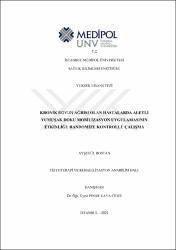| dc.contributor.advisor | Kaya Ciddi, Pınar | |
| dc.contributor.author | Bostan, Ayşegül | |
| dc.date.accessioned | 2021-09-08T09:05:31Z | |
| dc.date.available | 2021-09-08T09:05:31Z | |
| dc.date.issued | 2021 | en_US |
| dc.date.submitted | 2021-01-06 | |
| dc.identifier.citation | Bostan, A. (2021). Kronik boyun ağrısı olan hastalarda aletli yumuşak doku mobilizasyon uygulamasının etkinliği: Randomize kontrollü çalışma. (Yayınlanmamış yüksek lisans tezi). İstanbul Medipol Üniversitesi Sağlık Bilimleri Enstitüsü, İstanbul. | en_US |
| dc.identifier.uri | https://hdl.handle.net/20.500.12511/8039 | |
| dc.description.abstract | Bu çalışmada kronik boyun ağrısı olan hastalarda aletli yumuşak doku mobilizasyon (AYDM) uygulamasının etkinliğinin araştırılması planlandı. Çalışmaya 17-70 yaş aralığında 48 kronik boyun ağrısı olan birey dahil edildi. Bireyler çalışma (n=24) ve kontrol (n=24) grubu olacak şekilde randomize olarak ikiye ayrıldı. Her bir gruptaki hastalar 4 hafta (20 seans) boyunca ısı ajanları, elektroterapi modaliteleri, germe, gevşeme, kuvvetlendirme ve postür egzersizlerinden oluşan geleneksel fizyoterapi programı (GFP) ile tedavi edildi. Çalışma grubunda GFP'ye ek olarak boyun bölgesi, üst trapez, skapula çevresine 4 hafta süresince, haftada 2 gün olmak üzere toplam 8 seans AYDM uygulandı. Tedavi öncesi ve sonrası bireylerin derin boyun fleksör kas enduransları (DBFKE), Görsel Analog Skalası (GAS) ve Kısa Ağrı Envanteri (KAE) ile ağrı şiddetleri, Boyun Özürlülük İndeksi (BÖİ) ile fonksiyonel durumları, Nottingham Sağlık Profili (NSP) ile yaşam kaliteleri tedavi ve tedavi memnuniyetleri değerlendirildi. Her iki grup için tedavi öncesi ve sonrası karşılaştırma yapıldığında ağrı şiddeti, fonksiyonel durum ve yaşam kalitesi sonuçlarında anlamlı iyileşmeler görülürken, DBFKE'deki iyileşme sadece çalışma grubunda anlamlıydı (p<0,05). Tedavi sonrası sonuçlar gruplar arası karşılaştırıldığında çalışma grubu kontrol grubuna göre GAS, KAE, NSP ve DBFKE açısından anlamlı bulunurken (p<0,05), BÖİ'de böyle bir durum görülmedi (p>0,05), ancak BÖİ için tedavinin etki büyüklüğü çalışma grubunda daha yüksekti (cohen's d: çalışma grubu; 2.4 kontrol grubu;1.6). Çalışmanın sonunda kronik boyun ağrısı olan bireylere GFP ile birlikte AYDM uygulamasının tek başına uygulanan GFP'ye göre ağrı, yaşam kalitesi ve kas enduransı üzerinde daha etkili olduğu ve geleneksel fizyoterapi uygulamalarının yanında alternatif olarak uygulanmasının faydalı olabileceği ortaya kondu. | en_US |
| dc.description.abstract | In this study, it was planned to investigate the effectiveness of instrument-assisted soft tissue mobilisation (IASTM) in patients with chronic neck pain. Forty eight individuals with chronic neck pain between the ages of 17-70 were included in the study. Individuals were randomly divided into two groups as study (n = 24) and control (n = 24) groups. Individuals in each group were treated for 4 weeks (20 sessions) with a traditional physiotherapy program (TFP) consisting of heat agents, electrotherapy modalities, stretching, relaxation, strengthening and posture exercises. In the study group, in addition to TFP, a total of 8 sessions of IASTM were applied to the neck region, upper trapezius, and around the scapula for 4 weeks, 2 days a week. In the study group, in addition to TFP, a total of 8 sessions of IASTM were applied to the neck region, upper trapezius, and around the scapula for 4 weeks, 2 days a week. Before and after treatment, deep neck flexor muscle endurance (DNFME), pain severity with Visual Analogue Scale (VAS) and Brief Pain Inventory (BPI), functional status with Neck Disability Index (NDI), quality of life with Nottingham Health Profile (NHP) treatment and treatment satisfaction was evaluated. When the comparison was made before and after the treatment for both groups, significant improvements were observed in pain intensity, functional status and quality of life results, while improvement in DBFKI was significant only in the study group (p <0.05). When the results after the treatment were compared between the groups, the study group was found to be significant in terms of VAS, CAE, NSP and DBFKI compared to the control group (p <0.05), but such a situation was not observed in the BSI (p> 0.05), but the effect size of the treatment for BSI was higher in the study group (cohen's d: study group; 2.4, control group; 1.6). At the end of the study, it was seen that the IASTM technique applied to individuals with chronic neck pain in addition to TFP was more effective in pain, quality of life, muscle endurance. | en_US |
| dc.language.iso | tur | en_US |
| dc.publisher | İstanbul Medipol Üniversitesi Sağlık Bilimleri Enstitüsü | en_US |
| dc.rights | info:eu-repo/semantics/openAccess | en_US |
| dc.subject | Ağrı | en_US |
| dc.subject | Aletli Yumuşak Doku Mobilizasyonu | en_US |
| dc.subject | Kas Endurans Kronik Boyun Ağrısı | en_US |
| dc.subject | Yaşam Kalitesi | en_US |
| dc.subject | Pain | en_US |
| dc.subject | Chronic Neck Pain | en_US |
| dc.subject | Instrumental Soft Tissue Mobilization | en_US |
| dc.subject | Muscle Endurance | en_US |
| dc.subject | Quality of Life | en_US |
| dc.title | Kronik boyun ağrısı olan hastalarda aletli yumuşak doku mobilizasyon uygulamasının etkinliği: Randomize kontrollü çalışma | en_US |
| dc.title.alternative | The effects of instrument assisted soft tissue mobilization for patients with chronic neck pain: A randomized controlled trial | en_US |
| dc.type | masterThesis | en_US |
| dc.department | İstanbul Medipol Üniversitesi, Sağlık Bilimleri Enstitüsü, Fizyoterapi ve Rehabilitasyon Ana Bilim Dalı | en_US |
| dc.relation.publicationcategory | Tez | en_US |


















